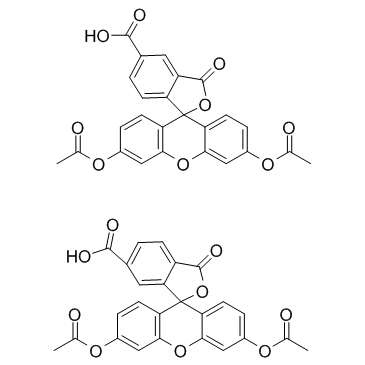5(6)-Carboxyfluorescein Diacetate

5(6)-Carboxyfluorescein Diacetate structure
|
Common Name | 5(6)-Carboxyfluorescein Diacetate | ||
|---|---|---|---|---|
| CAS Number | 124387-19-5 | Molecular Weight | 460.39 | |
| Density | N/A | Boiling Point | N/A | |
| Molecular Formula | C25H16O9 | Melting Point | N/A | |
| MSDS | Chinese USA | Flash Point | N/A | |
|
Contractile activity of human follicular dendritic cells.
Immunol. Cell Biol. 92(10) , 851-9, (2014) Follicular dendritic cells (FDCs) present antigens to B cells in the lymphoid follicle and inhibit B-cell apoptosis. In previous work, we obtained human FDC lines that allowed us to study the antigen phenotype and functions of these cells, finding that they e... |
|
|
Chloroplasts extend stromules independently and in response to internal redox signals.
Proc. Natl. Acad. Sci. U. S. A. 112 , 10044-9, (2015) A fundamental mystery of plant cell biology is the occurrence of "stromules," stroma-filled tubular extensions from plastids (such as chloroplasts) that are universally observed in plants but whose functions are, in effect, completely unknown. One prevalent h... |
|
|
Effects of vitamin D receptor knockout on cornea epithelium gap junctions.
Invest. Ophthalmol. Vis. Sci. 55(5) , 2975-82, (2014) Gap junctions are present in all corneal cell types and have been shown to have a critical role in cell phenotype determination. Vitamin D has been shown to influence cell differentiation, and recent work demonstrates the presence of vitamin D in the ocular a... |
|
|
Involvement of soluble scavenger receptor A in suppression of T cell activation in patients with chronic hepatitis B.
BMC Immunol. 16 , 29, (2015) Scavenger receptor A (SRA) is expressed predominantly in phagocytic cells playing an essential role in the host immune defense against invading microorganisms. Our previous study reported the presence of SRA in a soluble form in patients with infection of hep... |
|
|
Wogonin reverses multi-drug resistance of human myelogenous leukemia K562/A02 cells via downregulation of MRP1 expression by inhibiting Nrf2/ARE signaling pathway.
Biochem. Pharmacol. 92(2) , 220-34, (2014) Constitutive NF-E2-related factor 2 (Nrf2) activation has been recently reported to play a pivotal role in enhancing cell survival and resistance to anticancer drugs in many tumors. Previously, much effort has been devoted to the investigation of blocking Nrf... |
|
|
Hepatitis C virus-induced reduction in miR-181a impairs CD4(+) T-cell responses through overexpression of DUSP6.
Hepatology 61(4) , 1163-73, (2015) T cells play a crucial role in viral clearance or persistence; however, the precise mechanisms that control their responses during viral infection remain incompletely understood. MicroRNA (miR) has been implicated as a key regulator controlling diverse biolog... |
|
|
Eimeria bovis-triggered neutrophil extracellular trap formation is CD11b-, ERK 1/2-, p38 MAP kinase- and SOCE-dependent.
Vet. Res. 46 , 23, (2015) Eimeria bovis is an important coccidian parasite that causes high economic losses in the cattle industry. We recently showed that polymorphonuclear neutrophils (PMN) react upon E. bovis sporozoite exposure by neutrophil extracellular trap (NET) formation. We ... |
|
|
Tissue factor-positive tumor microvesicles activate platelets and enhance thrombosis in mice.
J. Thromb. Haemost. 14 , 153-66, (2016) ESSENTIALS: Cancer patients have a high rate of venous thrombosis (VT) but the underlying mechanisms are unknown. Tumor-derived, tissue factor-positive microvesicles in platelet activation in vitro and in vivo were studied. Tumor-derived, tissue factor-positi... |
|
|
Glutamine, glutamate, and arginine-based acid resistance in Lactobacillus reuteri.
Food Microbiol. 42 , 172-80, (2014) This study aimed to determine whether glutamine deamidation improves acid resistance of Lactobacillus reuteri, and to assess whether arginine, glutamine, and glutamate-mediated acid resistance are redundant or complementary mechanisms of acid resistance. Thre... |
|
|
FTIR microspectroscopy defines early drug resistant human hepatocellular carcinoma (HepG2) cells.
Exp. Cell Res. 340 , 71-80, (2016) Characterization and identification of cancer cell, chemotherapy, resistance is important for both routine cancer therapy and trouble-shooting the medication treatment regimen. Present techniques for characterizing cancer cell resistance require multiple meth... |